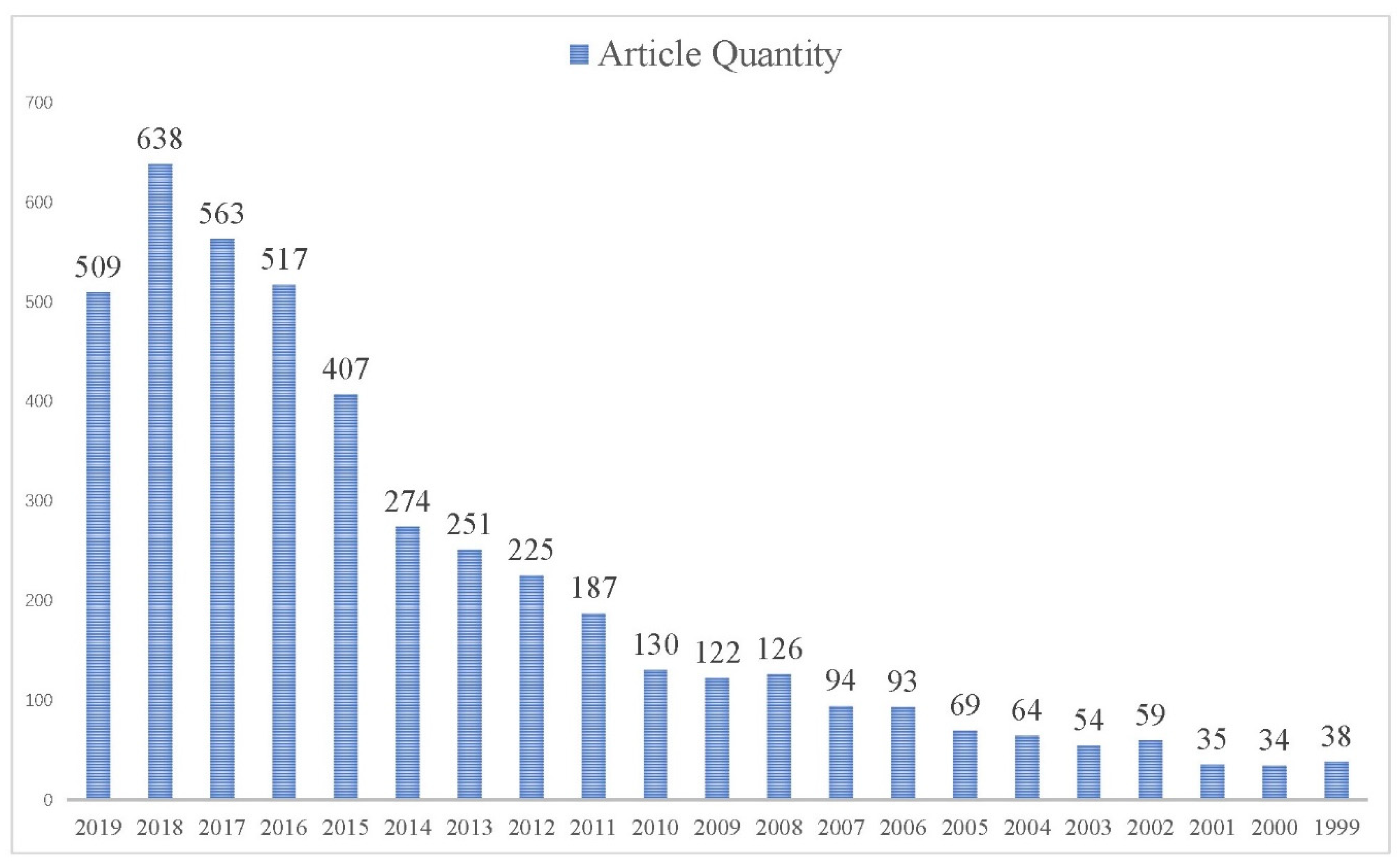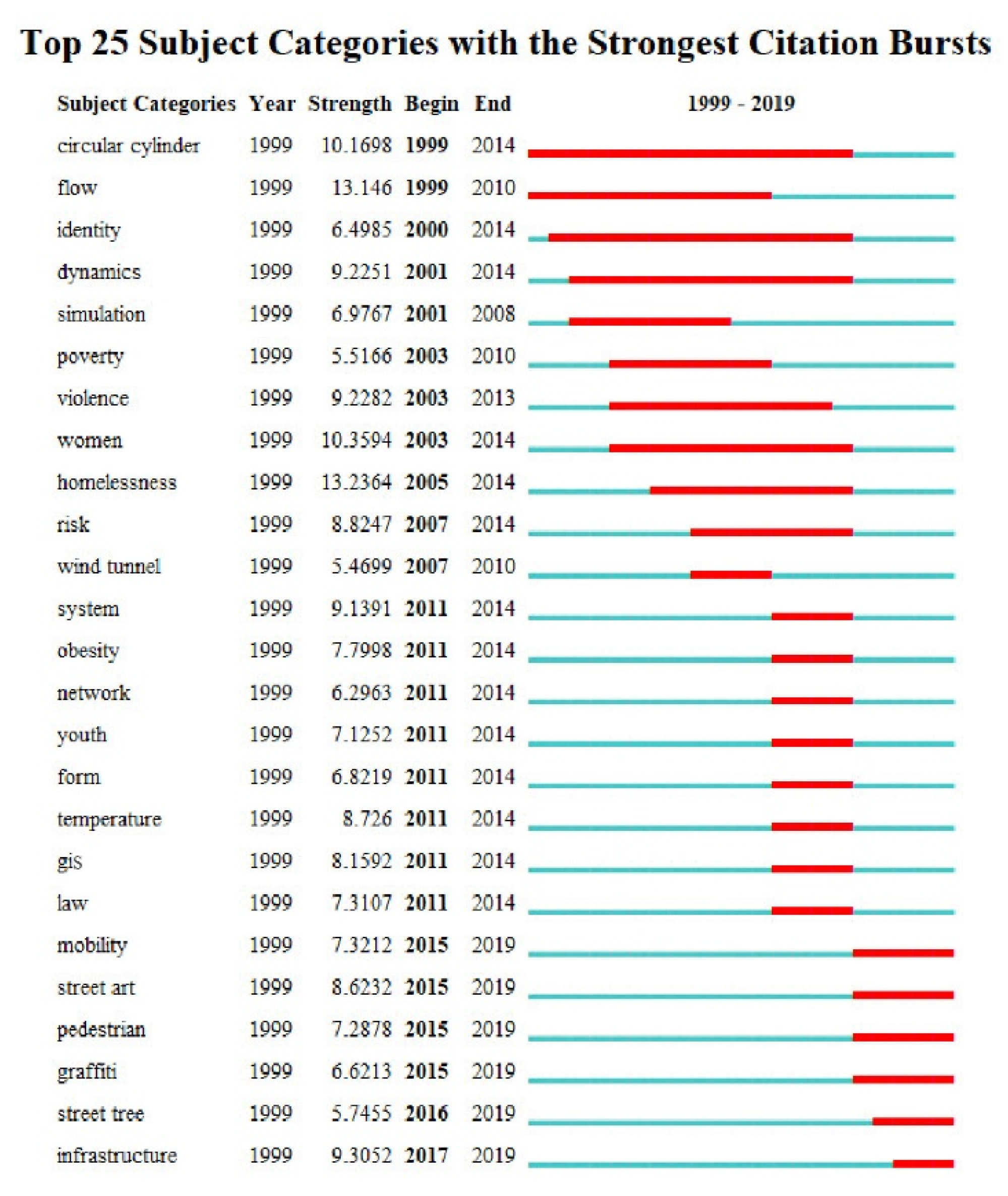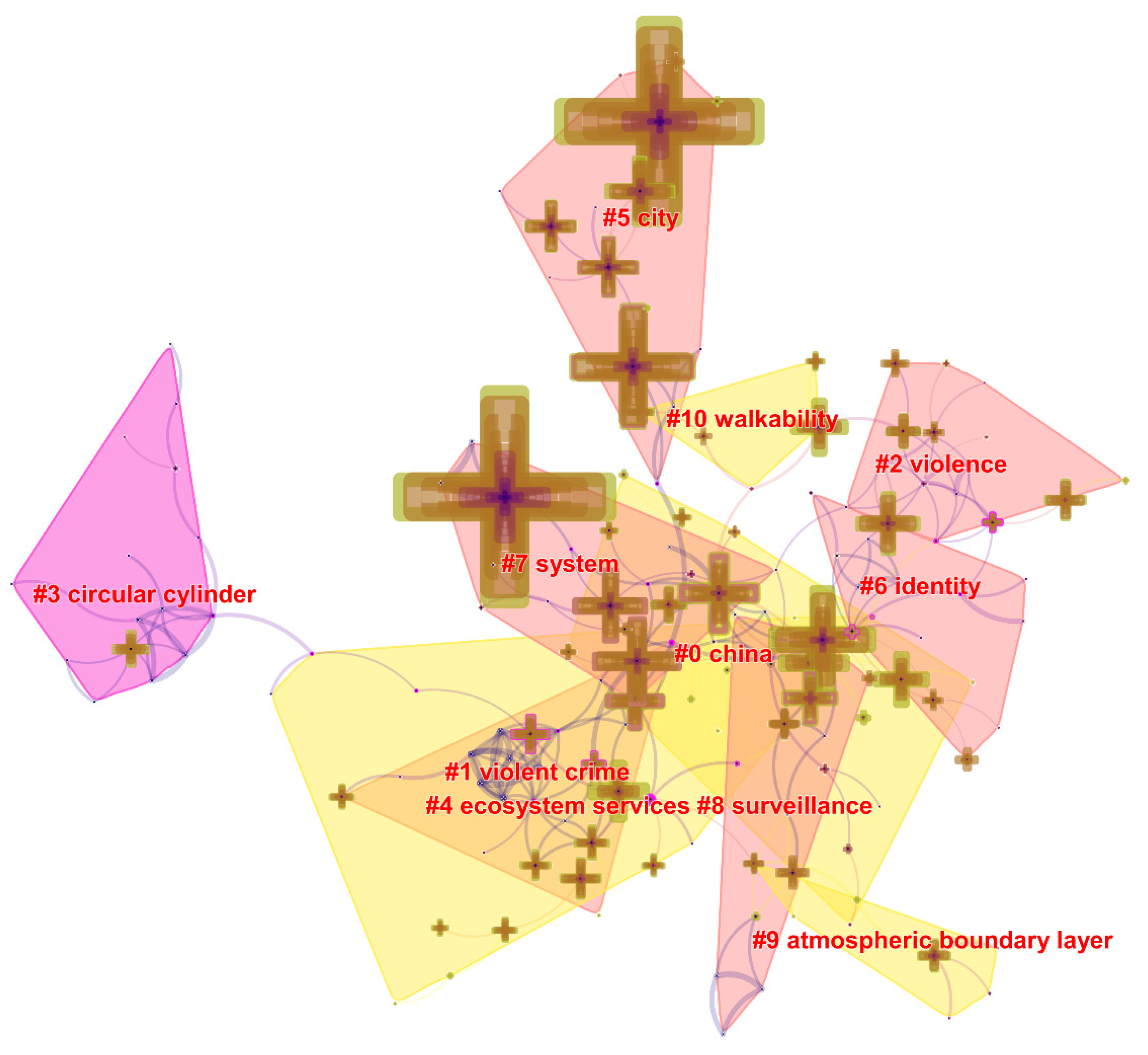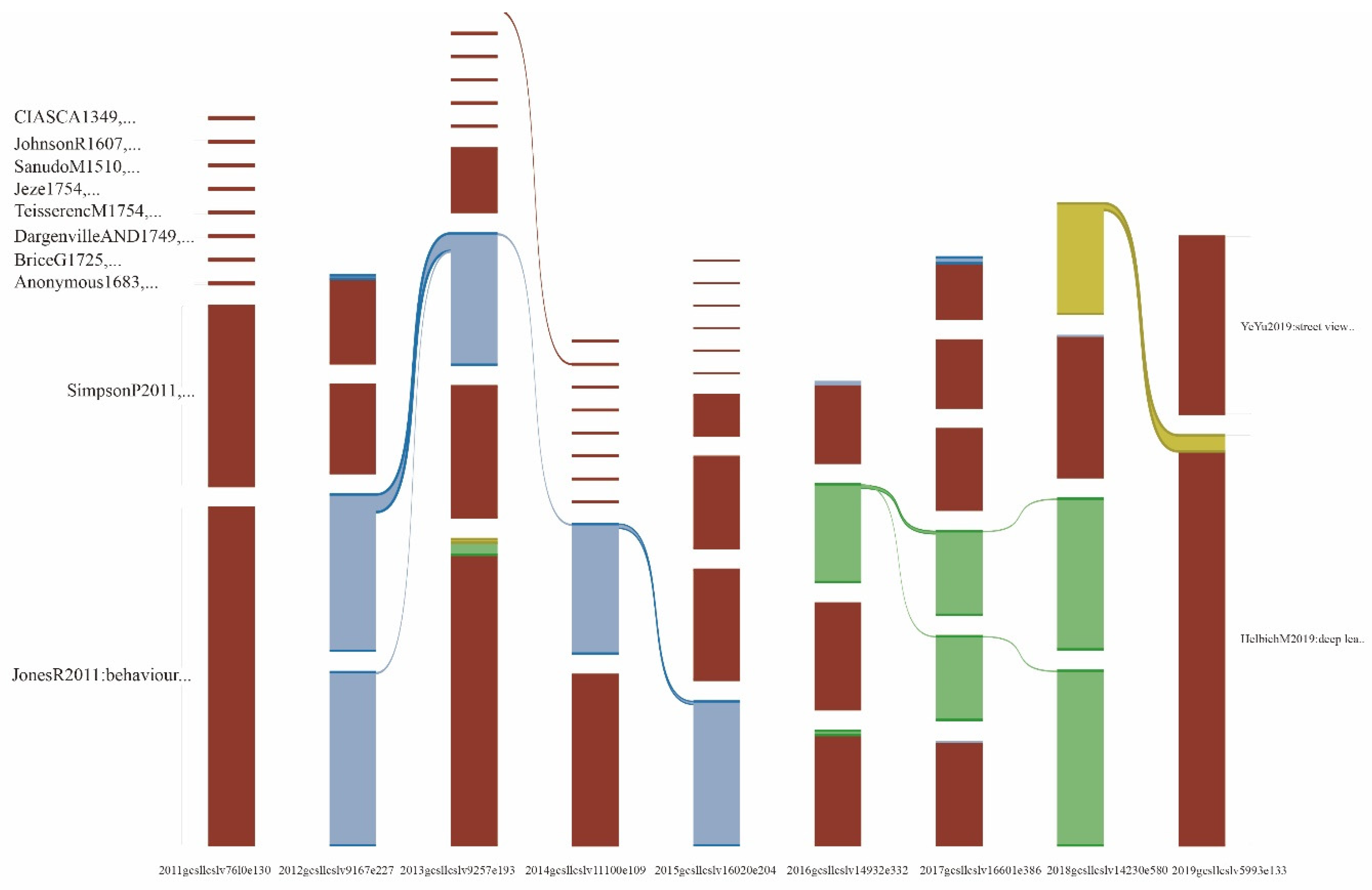Knowledge Atlas on the Relationship between Urban Street Space and Residents’ Health—A Bibliometric Analysis Based on VOSviewer and CiteSpace
Abstract
:1. Introduction
Every city in the western world, more or less, has the characteristics of ‘Coketown’. The main creativity of the 19th century produced an extremely deteriorating urban environment that has never been achieved before; because even the ruling class settlements were polluted and very crowded. Indeed, the richest and most ’advanced’ metropolises don’t even have enough sunshine and fresh air to build basic things that are indispensable to life, but backward villages still have these things.[5]
- The continuous emergence of new technologies and methods provides new possibilities for research;
- How to consider other disciplines so that the research content can be an effective system for solving problems.
2. Data Sources and Methods
2.1. Data Sources
2.2. Research Method
3. Analysis of Developments in Research Fields
3.1. Literature Development Trends
3.2. Country and Research Institute Analysis
4. Theme and Domain Co-occurrence Analysis
4.1. Keywords Co-occurrence
4.2. Domain Co-occurrence
5. Co-cited
6. Knowledge Topic Identification and Landmark Literature Analysis
6.1. Knowledge Topic Recognition
6.2. Analysis of Street Space and Residents’ Health Evolution Based on Iconic Literature
7. Discussion
Author Contributions
Funding
Acknowledgments
Conflicts of Interest
References
- U.S. Bureau of the Census. Historical Statistics of the United States 1789—1945; U.S. Govt: Washington, DC, USA, 1949; p. 25.
- Edwin Chadwick Biography (1800–1890). Available online: http://www.faqs.org/health/bios/66/Edwin-Chadwick.html (accessed on 12 December 2019).
- Li, J. The way out for health predicament in urbanization. Hist. Res. Anhui 2015, 3, 115–122. [Google Scholar]
- Burnstein, D.E. Next to Godliness: Confronting Dirt and Despair in Progressive Era New York City; University of Illinois Press: Chicago, IL, USA, 2006; p. 141. [Google Scholar]
- Murnford, L. The City in History; Mariner Books: London, UK, 2009. [Google Scholar]
- Li, Y. Theories of Urban Space Susceptible Cause Diseases; China Architecture & Building Press: Beijing, China, 2016; p. 67. [Google Scholar]
- WHO. Preamble to the Constitution of the World Health Organization; World Health Organization: New York, NY, USA, 1946; p. 1. [Google Scholar]
- Public-Space. Available online: https://new.unhabitat.org/topic/public-space (accessed on 6 November 2019).
- Jacobs, J. The Death and Life of Great American Cities; Modern Library: New York, NY, USA, 1993; p. 56. [Google Scholar]
- Goffman, E. Behavior in Public Places: Notes on the Social Organization of Gatherings; Free Press: New York, NY, USA, 1963; pp. 78–90. [Google Scholar]
- Whyte, W.H. The Social Life of Small Urban Spaces; Ye, Q., Ni, X., Eds.; Shanghai Translation Publishing House: Shanghai, China, 2016; pp. 116–120. [Google Scholar]
- Ungers, O.M. Morphologies: City Metaphors; Walther Koning. Verlag der Buchh and Lung König: Cologne, Germany, 2011; pp. 35–57. [Google Scholar]
- Barton, H.; Grant, M.; Guise, R. Shaping Neighborhoods: a guide for Health, Sustainability and Vitality? Spon Press: London, UK, 2003; pp. 66–78. [Google Scholar]
- New York City. Active Design Guidelines: Promoting Physical Activity and Health in Design; NYC: New York, NY, USA, 2011; pp. 13–18.
- Jamison, D.T.; Summers, L.H.; Alleyne, G. Global health 2035: A world converging within a generation. Lancet 2013, 382, 1898–1955. [Google Scholar] [CrossRef]
- Xu, L.Q.; Meng, R.X.; Huang, S.Q.; Chen, Z. Healing-oriented street design: exploration based on VR experiment. Urban Plan. Int. 2019, 1, 38–45. [Google Scholar] [CrossRef]
- Non-Communicable Diseases. Available online: https://www.who.int/zh/news-room/fact-sheets/detail/noncommunotable-diseases (accessed on 6 November 2019).
- Chen, Y.; Chen, C.M.; Liu, Z.Y. Methodological function of CiteSpace knowledge map. Sci. Res. 2015, 33, 242–253. [Google Scholar]
- Li, J.; Chen, C.M. CiteSpace: Scientific Text Mining and Visualization; Capital University of Economics and Business Press: Beijing, China, 2016; pp. 78–89. [Google Scholar]
- Waltman, L.; Eck, N.J.V.; Noyons, E.C.M. A unified approach to mapping and clustering of bibliometric networks. J. Informetr. 2010, 4, 629–635. [Google Scholar] [CrossRef] [Green Version]
- Callon, M.; Courtial, J.P.; Laville, F. Co- word analysis as a tool for describing the network of interactions between basic and technological research. The case of polymer chemistry. Scientometrics 1991, 22, 155–205. [Google Scholar] [CrossRef]
- Law, J.; Whittaker, J. Mapping acidification research: A test of the co-word method. Scientometrics 1992, 3, 417–461. [Google Scholar] [CrossRef]
- Kleinberg, J. Bursty and hierarchical structure in streams. In Proceedings of the 8th ACM SIGKDD International Conference on Knowledge Discovery and Data Mining, Edmonton, AB, Canada, 23–26 July 2002; pp. 91–101. [Google Scholar]
- Chen, C.M.; Chen, Y.; Hou, J. CiteSpace II: Identification and visualization of new trends and new dynamics in scientific literature. J. China Soc. Inf. Sci. 2009, 28, 401–421. [Google Scholar]
- Bowler, D.E.; Buyung-Ali, L.; Knight, T.M.; Pullin, A.S. Urban greening to cool towns and cities: A systematic review of the empirical evidence. Landsc. Urban Plan. 2010, 97, 147–155. [Google Scholar] [CrossRef]
- Hartig, T.; Mitchell, R.; Vries, S.D.; Frumkin, H. Nature and health. Public Health 2014, 35, 207–228. [Google Scholar] [CrossRef] [Green Version]
- Gehl, J. Life Between Buildings: Using Public Space; Island Press: Washington, UK, 2011; pp. 56–66. [Google Scholar]
- Oliveira, S.; Andrade, H.; Vaz, T. The cooling effect of green spaces as a contribution to the mitigation of urban heat: A case study in Lisbon. Build. Environ. 2011, 46, 2186–2194. [Google Scholar] [CrossRef]
- Hyunjung, L.; Helmut, M.; Liang, C. Contribution of trees and grasslands to the mitigation of human heat stress in a residential district of Freiburg, Southwest Germany. Landsc. Urban Plan. 2016, 148, 37–50. [Google Scholar]
- Buccilieri, R.; Sandberg, M.; Sabatino, S.D. City breathability and its link to pollutant concentration distribution with in urban-like geometries. Atmos. Environ. 2010, 44, 1894–1903. [Google Scholar] [CrossRef]
- Edward, N.; Vicky, C. Urban human thermal comfort in hot and humid Hong Kong. Energy Build. 2012, 55, 51–65. [Google Scholar]
- Angeliki, C.; Simos, Y. Street canyon design and improvement potential for urban open spaces; the influence of canyon aspect ratio and orientation on microclimate and outdoor comfort. Sustain. Cities Soc. 2017, 33, 85–101. [Google Scholar]
- Hwang, R.L.; Lin, T.P.; Matzarakis, A. Seasonal effects of urban street shading on long-term outdoor thermal comfort. Build. Environ. 2011, 46, 863–870. [Google Scholar] [CrossRef]
- Thompson, C.W.; Roe, J.; Aspinall, P.; Mitchell, R.; Clow, A.; Miller, D. More green space is linked to less stress in deprived communities: Evidence from salivary cortisol patterns. Landsc. Urban Plan. 2012, 105, 221–229. [Google Scholar] [CrossRef] [Green Version]
- Wolch, J.R.; Byrne, J.A.; Newell, J.P. Urban green space, public health, and environmental justice: The challenge of making cities ‘just green enough’. Landsc. Urban Plan. 2014, 125, 234–244. [Google Scholar] [CrossRef] [Green Version]
- Cohen, P.; Potchter, O.; Matzarakis, A. Daily and seasonal climatic conditions of green urban open spaces in the Mediterranean climate and their impact on human comfort. Build. Environ. 2012, 51, 285–295. [Google Scholar] [CrossRef]
- Lin, T.P.; Tsai, K.T.; Liao, C.C.; Huang, Y.C. Effects of thermal comfort and adaptation on park attendance regarding different shading levels and activity types. Build. Environ. 2013, 59, 599–611. [Google Scholar] [CrossRef]
- Xiao, Y.; Orford, S.; Webster, C.J. Urban configuration, accessibility, and property prices: A case study of Cardiff. Environ. Plan. B Plan. Des. 2015, 42, 1–12. [Google Scholar] [CrossRef] [Green Version]
- Law, S. Defining Street-based Local Area and measuring its effect on house price using a hedonic price approach: The case study of Metropolitan London. Cities 2017, 60, 166–179. [Google Scholar] [CrossRef] [Green Version]
- Barthelemy, M. From paths to blocks: New measures for street patterns. Environ. Plan. B Plan. Des. 2017, 44, 256–271. [Google Scholar] [CrossRef]
- Lu, Y.; Sarkar, C.; Xiao, Y. The effect of street-level greenery on walking behavior: Evidence from Hong Kong. Soc. Sci. Med. 2018, 208, 41–49. [Google Scholar] [CrossRef]
- Hartig, T. Green space, psychological restoration, and health inequality. Lancet 2008, 372, 1614–1615. [Google Scholar] [CrossRef]
- Hartig, T. Three steps to understanding restorative environments as health resources. In Open Space: People Space; Thompson, C., Travlou, P., Eds.; Taylor and Francis: Abingdon, UK, 2007; pp. 163–179. [Google Scholar]
- Patz, J.A.; Campbell-Lendrum, D.; Holloway, T.; Foley, J.A. Impact of regional climate change on human health. Nature 2005, 438, 310–317. [Google Scholar] [CrossRef]
- Nielsen, T.S.; Hansen, K.B. Do green areas affect health? Results from a Danish survey on the use of green areas and health indicators. Health Place 2007, 13, 839–850. [Google Scholar] [CrossRef]
- Erell, E.; Pearlmutter, D.; Boneh, D.; Bar Kutiel, P. Effect of high-albedo materials on pedestrian heat stress in urban street canyons. Urban Clim. 2014, 10, 367–386. [Google Scholar] [CrossRef]
- Holst, J.; Mayer, H. Impacts of street design parameters on human- biometeorological variables. Meteorol. Z. 2011, 20, 541–552. [Google Scholar] [CrossRef]
- Taleghani, M.; Kleerekoper, L.; Tenpierik, M.; Dobbelsteen, V.D.A. Out- door thermal comfort within five different urban forms in the Netherlands. Build. Environ. 2015, 83, 65–78. [Google Scholar] [CrossRef]
- Li, X.J.; Zhang, C.R.; Li, W.D.; Ricard, R.; Meng, Q.Y.; Zhang, W.X. Assessing street- level urban greenery using Google Street View and a modified green view index. Urban For. Urban Green. 2015, 14, 675–685. [Google Scholar] [CrossRef]
- Liang, J.M.; Gong, J.H.; Sun, J.; Zhou, J.P.; Li, W.H.; Li, Y.; Shen, S. Automatic sky view factor estimation from street view photographs—A big data approach. Remote Sens. 2017, 9, 411. [Google Scholar] [CrossRef] [Green Version]
- Gascon, M.; Triguero-Mas, M.; Martinez, D.; Dadvand, P.; Forns, J.; Plasencia, A.; Nieuwenhuijsen, M.J. Mental health benefits of long-term exposure to residential green and blue spaces: A systematic review. Int. J. Environ. Res. Public Health 2015, 12, 4354–4379. [Google Scholar] [CrossRef] [PubMed] [Green Version]
- Markevych, I.; Schoierer, J.; Hartig, T.; Chudnovsky, A.; Hystad, P.; Dzhambov, A.M.; de Vires, S.; Triguero-Mas, M.; Brauer, M.; Nieuwenhuijsen, M.J.; et al. Exploring pathways linking greenspace to health: Theoretical and methodological guidance. Environ. Res. 2017, 158, 301–317. [Google Scholar] [CrossRef] [PubMed]
- Sarkar, C.; Webster, C.; Pryor, M.; Tang, D.; Melbourne, S.; Zhang, X.H.; Liu, J.Z. Exploring associations between urban green, street design and walking: Results from the Greater London boroughs. Landsc. Urban Plann. 2015, 143, 112–125. [Google Scholar] [CrossRef]
- Porta, S.; Strano, E.; Iacoviello, V.; Messora, R. Street centrality and densities of retail and services in Bologna, Italy. Environ. Plan. B Plan. Des. 2009, 36, 450–465. [Google Scholar] [CrossRef] [Green Version]
- Cheng, V.; Ng, E. Thermal comfort in urban open spaces for Hong Kong. Archit. Sci. Rev. 2006, 49, 236–242. [Google Scholar] [CrossRef]
- Thorsson, S.; Honjo, T.; Lindberg, F.; Eliasson, I.; Lim, E.M. Thermal comfort and outdoor activity in Japanese urban public places. Environ. Behav. 2007, 39, 660–684. [Google Scholar] [CrossRef]
- Hang, J.; Sandberg, M.; Li, Y.G. Flow mechanisms and flow-capacity in idealized long-street models. Build. Environ. 2010, 45, 1042–1053. [Google Scholar] [CrossRef]
- Buccolieri, R.; Gromke, C.; Di Sabatino, S.; Ruck, B. Aerodynamics effects of trees on pollutant concentration in street canyons. Sci. Total Environ. 2009, 407, 5247–5256. [Google Scholar] [CrossRef]
- Di Sabatino, S.; Buccolieri, R.; Pulvirenti, B.; Britter, R.E. Flow and pollutant dispersion in street canyons using FLUENT and ADMS-Urban. Environ. Modeling Assess. 2008, 13, 369–381. [Google Scholar] [CrossRef]
- Pearlmutter, D.; Berliner, P.; Shaviv, E. Integrated modeling of pedestrian energy exchange and thermal comfort in urban street canyons. Build. Environ. 2007, 42, 2396–2409. [Google Scholar] [CrossRef]
- Ali-Toudert, F.; Mayer, H. Numerical study on the effects of aspect ratio and orientation of an urban street canyon on outdoor thermal comfort in hot and dry climate. Build. Environ. 2006, 41, 94–108. [Google Scholar] [CrossRef]
- Chao, Y.; Edward, N. Practical application of CFD on environmentally sensitive architectural design at high density cities: A case study in Hong Kong. Urban Clim. 2014, 8, 57–77. [Google Scholar]
- Giridharan, R.; Lau, S.S.Y.; Ganesan, S.; Givoni, B. Urban design factors influencing heat island intensity in high-rise high-density environments of Hong Kong. Build. Environ. 2007, 42, 69–84. [Google Scholar] [CrossRef]
- Barthelemy, M. Betweenness centrality in large complex networks. Eur. Phys. J. B 2004, 38, 163–168. [Google Scholar] [CrossRef]
- Michael, B. Cities and Complexity; The MIT Press: Cambridge, MA, USA, 2005; pp. 67–86. [Google Scholar]
- Jiang, B.; Claramunt, C. Topological analysis of urban street networks. Environ. Plan. B 2004, 31, 151–162. [Google Scholar] [CrossRef] [Green Version]
- Sergio, P.; Paolo, C.; Vito, L. The network analysis of urban streets: A primal approach. Environ. Plan. 2006, B33, 705–725. [Google Scholar]
- Penn, A. Space syntax and spatial cognition or why the axial line? Environ. Behav. 2003, 35, 30–65. [Google Scholar] [CrossRef]
- Koohsari, M.J.; Karakiewicz, J.A.; Kaczynski, A.T. Public open space and walking: The role of proximity, perceptual qualities of the surrounding built environment, and street configuration. Environ. Behav. 2013, 45, 706–736. [Google Scholar] [CrossRef]
- Mitchell, R.; Popham, F. Greenspace, urbanity and health: Relationships in England. J. Epidemiol. Community Health 2007, 61, 681–683. [Google Scholar] [CrossRef] [PubMed] [Green Version]
- Sullivan, W.C.; Kuo, F.E.; Depooter, S.F. The fruit of urban nature vital neighborhood spaces. Environ. Behav. 2004, 36, 678–700. [Google Scholar] [CrossRef]
- Takano, T.; Nakamura, K.; Watanabe, M. Urban residential environments and senior citizens’ longevity in megacity areas: The importance of walkable green spaces. J. Epidemiol. Community Health 2002, 56, 913–918. [Google Scholar] [CrossRef] [Green Version]
- Bush, C.L.; Pittman, S.; McKay, S.; Ortiz, T.; Wong, W.W.; Klish, W.J. Park- based obesity intervention program for Inner-city Minority Children. J. Pediatrics 2007, 151, 513–517. [Google Scholar] [CrossRef] [PubMed]
- Byrne, J. When green is White: The cultural politics of race, nature and social exclusion in a Los Angeles urban national park. Geoforum 2012, 43, 595–611. [Google Scholar] [CrossRef] [Green Version]
- Byrne, J.; Wolch, J. Nature, race, and parks: Past research and future directions for geographic research. Prog. Hum. Geogr. 2009, 33, 743–765. [Google Scholar] [CrossRef] [Green Version]
- Dai, D. Racial/ethnic and socioeconomic disparities in urban green space accessibility: Where to intervene? Landsc. Urban Plan. 2011, 102, 234–244. [Google Scholar] [CrossRef]
- Almanza, E.; Jerrett, M.; Dunton, G.; Seto, E.; Pentz, M.A. A study of community design, greenness, and physical activity in children using satellite, GPS and accelerometer data. Health Place 2012, 18, 46–54. [Google Scholar] [CrossRef] [Green Version]
- De Vries, S.; Van Dillen, S.M.E.; Groenewegen, P.P.; Spreeuwenberg, P. Streetscape greenery and health: Stress, social cohesion and physical activity as mediators. Soc. Sci. Med. 2013, 94, 26–33. [Google Scholar] [CrossRef]
- Matzarakis, A.; Rutz, F.; Mayer, H. Modelling radiation fluxes in simple and complex environments: Basics of the RayMan model. Int. J. Biometeorol. 2010, 54, 131–139. [Google Scholar] [CrossRef] [Green Version]
- Lin, T.P.; Matzarakis, A.; Hwang, R.L. Shading effect on long-term outdoor thermal comfort. Build. Environ. 2010, 45, 213–221. [Google Scholar] [CrossRef]
- Shashua-Bar, L.; Pearlmutter, D.; Erell, E. The influence of trees and grass on outdoor thermal comfort in a hot-arid environment. Int. J. Climatol. 2011, 31, 1498–1506. [Google Scholar] [CrossRef]













| Count | Cited References | Year |
|---|---|---|
| 39 | LIN TP, BUILD ENVIRON, V45, P213 | 2010 |
| 39 | MATZARAKIS A, INT J BIOMETEOROL, V54, P131 | 2010 |
| 33 | SHASHUA-BARL, INT J CLMATOL, V31, P1498 | 2011 |
| 32 | WOLCH JR, LANDSCAPE URBAN PLAN, V125, P234 | 2014 |
| 29 | BOWLER DE, LANDSCAPE URBAN PLAN, V97, P147, | 2010 |
| 29 | GEHLJ,2011, LIFE BUILDINGS USING, VO, PO | 2011 |
| 26 | LI XJ, URBAN FOR URBAN GREE, V14, P675 | 2015 |
| 26 | LIN TP, BUILD ENVIRON, V44, P2017 | 2009 |
| 23 | LEE H, 2016, LANDSCAPE URBAN PLAN, V148, P37 | 2016 |
| 23 | MULLANEY J, 2015. LANDSCAPE URBAN PLAN, V134, P157 | 2015 |
| Research Categories and Elements | Research Method | Relevant Research Contents | ||
|---|---|---|---|---|
| Positive correlation between urban street space and residents’ health | Natural Environment | temperature, plants and geographical location | sensor measurement, ENVI-met model, literature meta analysis | Psychological restoration and physical activity to explain the health promoting value of green space [42,43]; Regional climate change [44]; Living away from green spaces may increase the risk of obesity [45]; High-albedo materials [46]; The sky view factor (SVF), significantly affects outdoor thermal environments [47,48]; Google Street View (GSV), urban greenery assessment tool [49,50];Three mechanisms through which greenery might exert its positive effect on health: stress reduction, stimulating physical activity and facilitating social cohesion [51,52,53]. |
| Economic Environment | economic level and house price of different cities | a topological network model, space syntax re- search, questionnaire investigation | Balancing the interests of all parties (local governments, different community groups, real estate developers, environmental advocates) [35]; The concept of Street-based Local Area (SLA), SLA associate with house price [39]; By estimating network accessibility variables across a variety of spatial scales, Evaluate the relationship between urban allocation and real estate price; Urban Street centrality and densities of commercial and service activities [54]. | |
| Physical Space Environment | transportation, street grid, built environment | computational fluid dynamics (CFD), standard ke3 turbulence model, micro-meteorological measurement, ENVI-met model, space syntax | The influence of thermal comfort of urban outdoor space environment on pedestrians [55,56]; Geometric elements and physical properties are related to microclimate and thermal comfort parameters as well as data from different climatic regions [32]; Long-street models [57]; The urban air permeability in the urban canopy is closely related to the building density [58]; A small building arrangement and pollutant dispersion in street canyons [59,60,61]; Environmental sensitivity and heat island intensity in high-density cities [62,63]; The betweenness centrality (BC) of nodes in large complex networks [64]; Planners and community police, the quality of life in urban neighborhoods [65]; The large urban street networks form small-world networks [66,67]; Cognitive space, metric space, spatial topological [68]; Built environment space perception [69]. | |
| Social Environment | gender, age, gentrification of land, environmental justice | salivary cortisol data, sampling survey | Measurement of salivary cortisol was used as a basis for exploring the relationship between happiness and green space [34]; The degree of urbanity and level of income deprivation [70]; The association between greenery filled public areas that are nearby a residence and easy to walk in and the longevity of senior citizens in a densely populated, developed megacity [71,72]; The obesity epidemic in minority children [73];Ethno-racially differentiated [74,75,76]; The relationship between children’s health and community, green plants and sports activities [77]; The time of outdoor activities are influenced by regional culture [78]. | |
© 2020 by the authors. Licensee MDPI, Basel, Switzerland. This article is an open access article distributed under the terms and conditions of the Creative Commons Attribution (CC BY) license (http://creativecommons.org/licenses/by/4.0/).
Share and Cite
Meng, L.; Wen, K.-H.; Brewin, R.; Wu, Q. Knowledge Atlas on the Relationship between Urban Street Space and Residents’ Health—A Bibliometric Analysis Based on VOSviewer and CiteSpace. Sustainability 2020, 12, 2384. https://doi.org/10.3390/su12062384
Meng L, Wen K-H, Brewin R, Wu Q. Knowledge Atlas on the Relationship between Urban Street Space and Residents’ Health—A Bibliometric Analysis Based on VOSviewer and CiteSpace. Sustainability. 2020; 12(6):2384. https://doi.org/10.3390/su12062384
Chicago/Turabian StyleMeng, Lingchao, Kuo-Hsun Wen, Richard Brewin, and Qiong Wu. 2020. "Knowledge Atlas on the Relationship between Urban Street Space and Residents’ Health—A Bibliometric Analysis Based on VOSviewer and CiteSpace" Sustainability 12, no. 6: 2384. https://doi.org/10.3390/su12062384
APA StyleMeng, L., Wen, K. -H., Brewin, R., & Wu, Q. (2020). Knowledge Atlas on the Relationship between Urban Street Space and Residents’ Health—A Bibliometric Analysis Based on VOSviewer and CiteSpace. Sustainability, 12(6), 2384. https://doi.org/10.3390/su12062384





